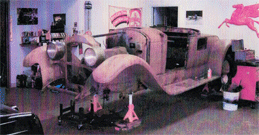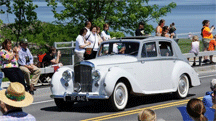 Christina and Paul McCaffrey’s ’54 Bentley
Christina and Paul McCaffrey’s ’54 Bentley
Are those Holley Carburetors we can see in the Bentley? Oh no, they are SUs, straight from the island!
We purchased our 1954 Bentley R-Type on 10/3/1999 from Philip Palmer – Starksboro. Original owner was Stephen John Pilkington of “The Quarries”, Quarry Drive, Ormskirk, Lancaster County, England. The vehicle was imported to Lake Placid NY in 1985. Chassis is a Standard Steel Saloon # B109ZX; 4 1/2 Litre; bench front seat; RHD; Coker Tires
We took it to the RROC ( The International Club for Bentley & Rolls-Royce Owners & Enthusiasts) national meet in Greenwich Connecticut where the local dealer completely over-hauled the brake system. They say that Bentley and Rolls Royce vehicles don’t breakdown – they only may experience “failure to proceed”. Our Bentley R-Type had a failure to stop! Once the work was finished it practically stood on the bonnet when the brakes were applied.
I grew up in Greenwich with six siblings. Our family car was always a Ford station wagon where we fought over the chance to sit in front “way back”. We took regular Sunday drives and played “punch buggy” when VW’s were spotted. My Mom always said she’d love a Rolls Royce if she could have any car she wanted. With a small inheritance from her, the Bentley became the first in our modest “collection”.
We have used it in a few family/close friends weddings. We’d love to do more but insurance restricts “commercial use”. Paul is the designated chauffeur – I’ve only driven it in parking lots and open fields. We have taken it to VAE shows in Stowe, Shelburne, St. Albans; Knight’s Point; Manchester VT; and has been a regular 1st place winner at the Bristish Invasion in Stowe. We enjoy the Tailgate competition and dressing in Vintage clothing of the 50’s era.
Bio: Paul and I were married in Ireland. We both work at the University of Vermont Medical Center in the Operating Room. Paul has been a surgical technician for 43 years; I am a neurosurgical nurse there. Paul served in the Army in Vietnam, was a City Councilor in Winooski, and was a private investigator. I formally worked as an independent stockbroker and as a Cost Estimator for General Electric/Lockheed Martin. We have five grown children: Lauren, Coberlin, Jameson, William James and John (Jack). Five grandchildren: Hillary, Marley, Paris, Taylor and Zoey. We also enjoy Lake Champlain – Sailing out of LCYC in Shelburne Bay and fishing.










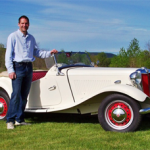 Please email all inquiries to:
Please email all inquiries to: 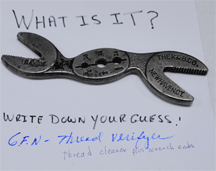 We were at a loss for what to bring to January “Memorabilia Meet”, when it occurred to me that we had a mysterious tool on the shelf that I had picked up at an antique store a couple of years back. Maybe it was automobile related. This might be an opportunity to get some educated opinions as to what it is. Wendell took it along and put a note on it asking for ideas as to its identity and use. We got some wild stabs, but no direct hits. Well, now this is the age of Google and computer search engines, so we subsequently gave that a try. Bingo! You probably never heard of an Alligator Wrench, but that’s what it is. Looking at it you can see where the name comes from. It was used mostly by steam locomotive maintenance workers to loosen nuts and pipes. I never would have guessed.
We were at a loss for what to bring to January “Memorabilia Meet”, when it occurred to me that we had a mysterious tool on the shelf that I had picked up at an antique store a couple of years back. Maybe it was automobile related. This might be an opportunity to get some educated opinions as to what it is. Wendell took it along and put a note on it asking for ideas as to its identity and use. We got some wild stabs, but no direct hits. Well, now this is the age of Google and computer search engines, so we subsequently gave that a try. Bingo! You probably never heard of an Alligator Wrench, but that’s what it is. Looking at it you can see where the name comes from. It was used mostly by steam locomotive maintenance workers to loosen nuts and pipes. I never would have guessed.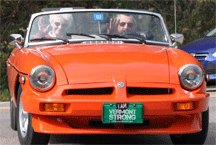

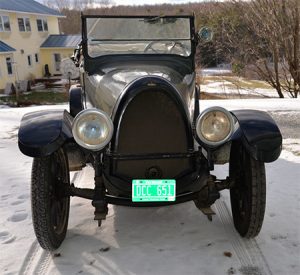
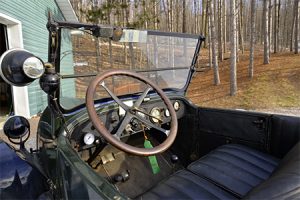 In Rutland, Vermont that year George Lamphere was shopping to buy a new car. He and his wife, Eva, lived at 3 Clarendon Avenue and their creamery & dry goods store on Main Street must have been doing fairly well. There were a number of auto dealerships in the area but the one at 107-109 West Street must have caught their eye because they sold an air cooled car where you didn’t have to worry about the radiator freezing up during the winter. Another thing they might have seen in the car ads was, “you could put the accelerator to the floor, even in the desert, and run it that way all day or until you ran out of gas”. That is how good these engines were. The dealership was named Rutland Machine and Auto Company and they sold Seldon trucks and Franklin Automobiles. The Franklin touring car pictured above is the car the Lampheres decided upon.
In Rutland, Vermont that year George Lamphere was shopping to buy a new car. He and his wife, Eva, lived at 3 Clarendon Avenue and their creamery & dry goods store on Main Street must have been doing fairly well. There were a number of auto dealerships in the area but the one at 107-109 West Street must have caught their eye because they sold an air cooled car where you didn’t have to worry about the radiator freezing up during the winter. Another thing they might have seen in the car ads was, “you could put the accelerator to the floor, even in the desert, and run it that way all day or until you ran out of gas”. That is how good these engines were. The dealership was named Rutland Machine and Auto Company and they sold Seldon trucks and Franklin Automobiles. The Franklin touring car pictured above is the car the Lampheres decided upon.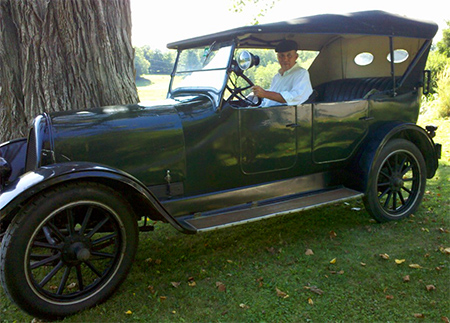 The Franklin Company had sold about 43,000 cars by 1919 and had the process fairly well perfected by then. They were using 6 cylinder engines in 1906 for some of their models and by 1914 all Franklins had six cylinder engines. Managing the air flow was important in these air cooled vehicles and until 1922 all that was required was a fan between the engine and the transmission to help “pull” the air through. As the horse power increased they moved the fan to the front of the engine and continued to use the cylinder fins to force air down past the hot cylinders, this was called a “down-drafter”. As the 6 cylinder engine power grew, from 24 HP to over 100HP, the company changed again in 1930, to keeping the fan in the front but now forcing air “across” the engine thus calling it a side drafter. A much more efficient way to keep the engine cool.
The Franklin Company had sold about 43,000 cars by 1919 and had the process fairly well perfected by then. They were using 6 cylinder engines in 1906 for some of their models and by 1914 all Franklins had six cylinder engines. Managing the air flow was important in these air cooled vehicles and until 1922 all that was required was a fan between the engine and the transmission to help “pull” the air through. As the horse power increased they moved the fan to the front of the engine and continued to use the cylinder fins to force air down past the hot cylinders, this was called a “down-drafter”. As the 6 cylinder engine power grew, from 24 HP to over 100HP, the company changed again in 1930, to keeping the fan in the front but now forcing air “across” the engine thus calling it a side drafter. A much more efficient way to keep the engine cool. If you are reading this, then Christmas is over and thoughts of putting this season away and what 2016 will bring are on your mind. Did I get what I wanted for Christmas? First, I don’t know because I wrote this 2 weeks before Christmas and second, I really didn’t ask for anything special but I’m sure I got something. We always say, ‘don’t get me anything’ but somehow can’t seem to honor the request. Just doesn’t seem right not to open something, no matter how small or silly. One of my favorites has always been dried pineapple, so one year I went to the natural food store and bought enough of it to fill my stocking! Probably at least 10 bags and maybe more, we all got a good laugh out of it, so it was sooo worth it! I forgot to tell you that some years Santa has been too busy to fill my stocking so I do it myself, which really isn’t so bad as I get exactly what I want and like and not what Santa is sure I’ll enjoy!
If you are reading this, then Christmas is over and thoughts of putting this season away and what 2016 will bring are on your mind. Did I get what I wanted for Christmas? First, I don’t know because I wrote this 2 weeks before Christmas and second, I really didn’t ask for anything special but I’m sure I got something. We always say, ‘don’t get me anything’ but somehow can’t seem to honor the request. Just doesn’t seem right not to open something, no matter how small or silly. One of my favorites has always been dried pineapple, so one year I went to the natural food store and bought enough of it to fill my stocking! Probably at least 10 bags and maybe more, we all got a good laugh out of it, so it was sooo worth it! I forgot to tell you that some years Santa has been too busy to fill my stocking so I do it myself, which really isn’t so bad as I get exactly what I want and like and not what Santa is sure I’ll enjoy!